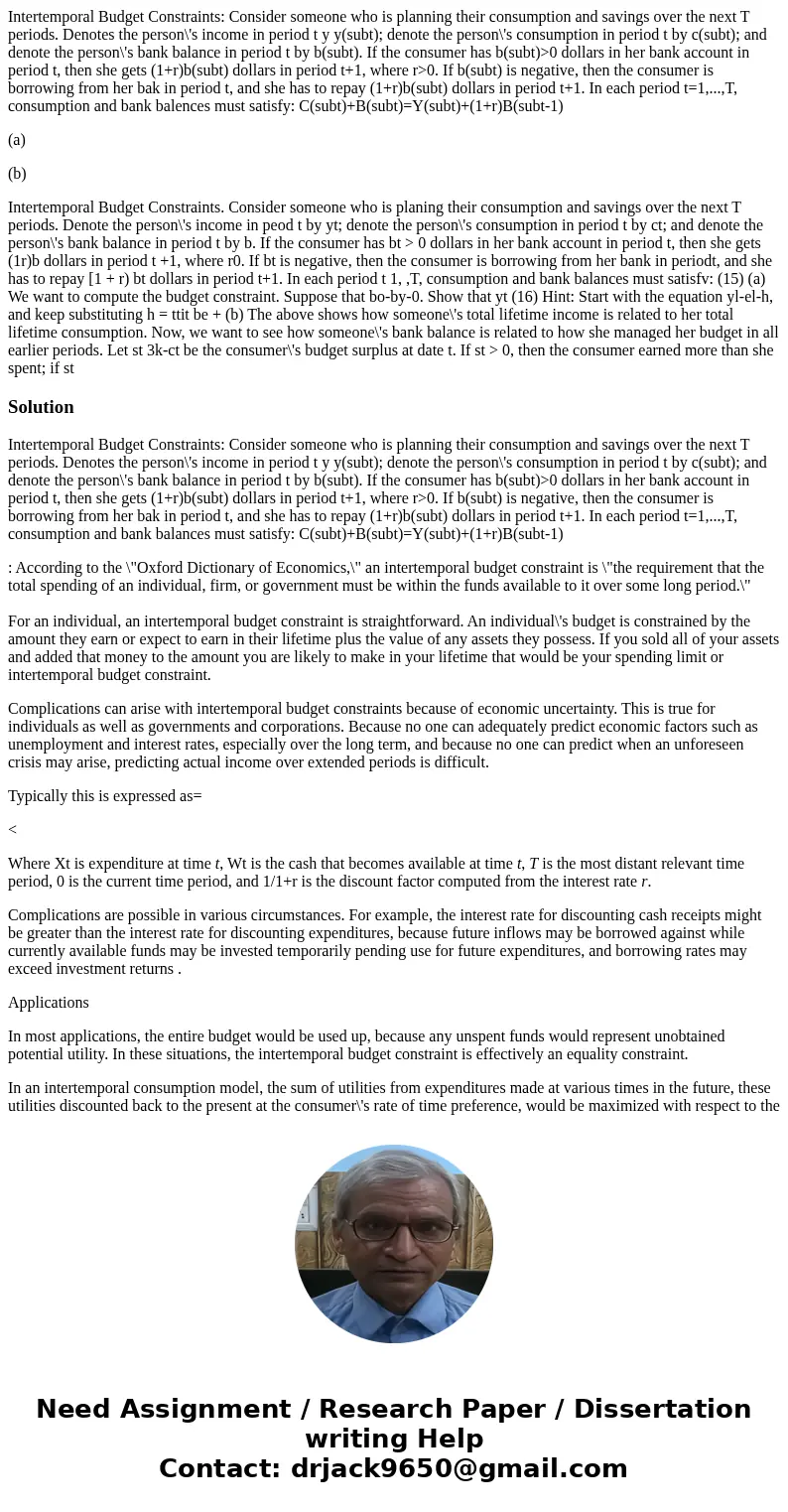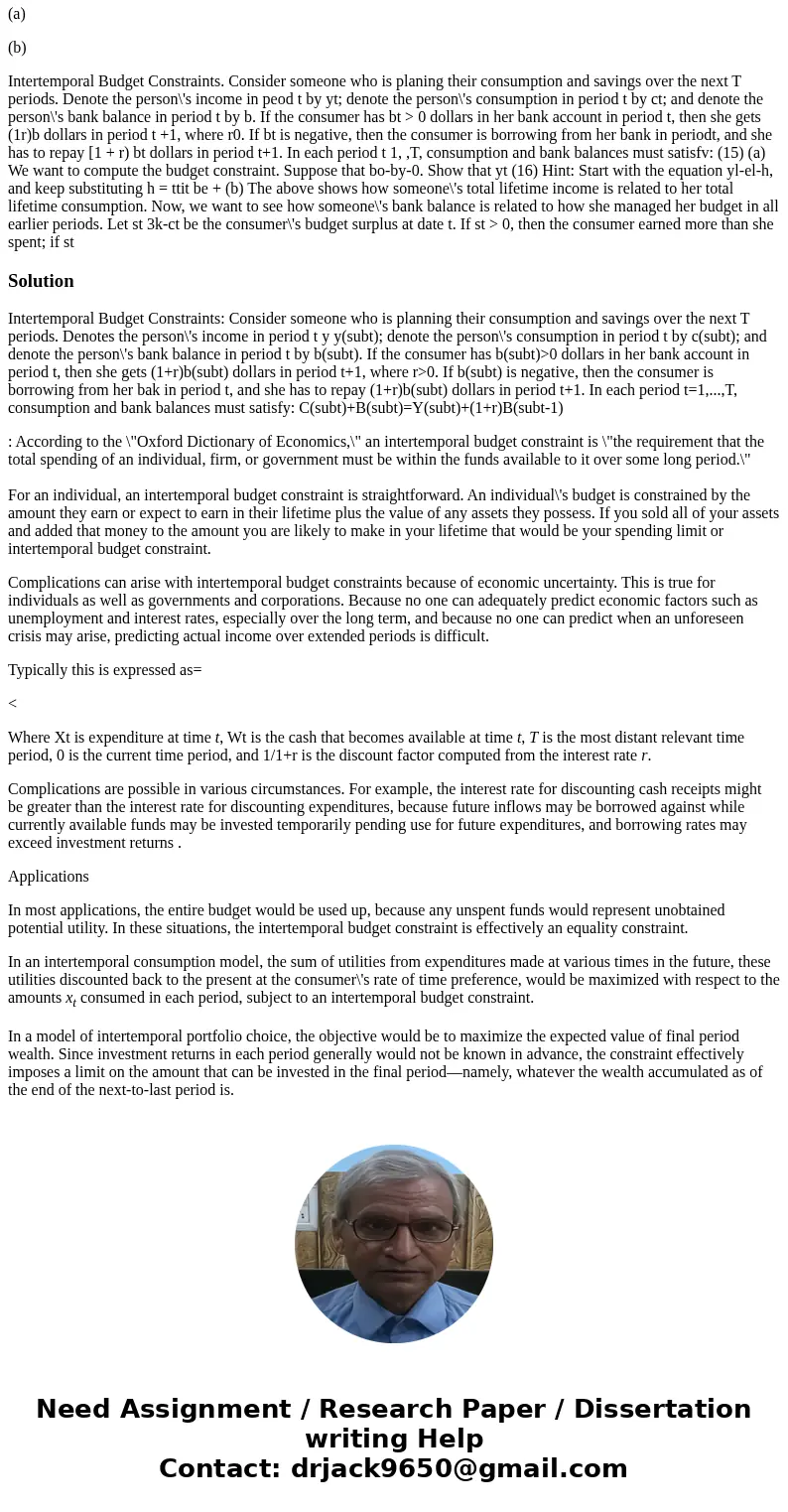Intertemporal Budget Constraints Consider someone who is pla
Intertemporal Budget Constraints: Consider someone who is planning their consumption and savings over the next T periods. Denotes the person\'s income in period t y y(subt); denote the person\'s consumption in period t by c(subt); and denote the person\'s bank balance in period t by b(subt). If the consumer has b(subt)>0 dollars in her bank account in period t, then she gets (1+r)b(subt) dollars in period t+1, where r>0. If b(subt) is negative, then the consumer is borrowing from her bak in period t, and she has to repay (1+r)b(subt) dollars in period t+1. In each period t=1,...,T, consumption and bank balences must satisfy: C(subt)+B(subt)=Y(subt)+(1+r)B(subt-1)
(a)
(b)
Intertemporal Budget Constraints. Consider someone who is planing their consumption and savings over the next T periods. Denote the person\'s income in peod t by yt; denote the person\'s consumption in period t by ct; and denote the person\'s bank balance in period t by b. If the consumer has bt > 0 dollars in her bank account in period t, then she gets (1r)b dollars in period t +1, where r0. If bt is negative, then the consumer is borrowing from her bank in periodt, and she has to repay [1 + r) bt dollars in period t+1. In each period t 1, ,T, consumption and bank balances must satisfv: (15) (a) We want to compute the budget constraint. Suppose that bo-by-0. Show that yt (16) Hint: Start with the equation yl-el-h, and keep substituting h = ttit be + (b) The above shows how someone\'s total lifetime income is related to her total lifetime consumption. Now, we want to see how someone\'s bank balance is related to how she managed her budget in all earlier periods. Let st 3k-ct be the consumer\'s budget surplus at date t. If st > 0, then the consumer earned more than she spent; if stSolution
Intertemporal Budget Constraints: Consider someone who is planning their consumption and savings over the next T periods. Denotes the person\'s income in period t y y(subt); denote the person\'s consumption in period t by c(subt); and denote the person\'s bank balance in period t by b(subt). If the consumer has b(subt)>0 dollars in her bank account in period t, then she gets (1+r)b(subt) dollars in period t+1, where r>0. If b(subt) is negative, then the consumer is borrowing from her bak in period t, and she has to repay (1+r)b(subt) dollars in period t+1. In each period t=1,...,T, consumption and bank balances must satisfy: C(subt)+B(subt)=Y(subt)+(1+r)B(subt-1)
: According to the \"Oxford Dictionary of Economics,\" an intertemporal budget constraint is \"the requirement that the total spending of an individual, firm, or government must be within the funds available to it over some long period.\"
For an individual, an intertemporal budget constraint is straightforward. An individual\'s budget is constrained by the amount they earn or expect to earn in their lifetime plus the value of any assets they possess. If you sold all of your assets and added that money to the amount you are likely to make in your lifetime that would be your spending limit or intertemporal budget constraint.
Complications can arise with intertemporal budget constraints because of economic uncertainty. This is true for individuals as well as governments and corporations. Because no one can adequately predict economic factors such as unemployment and interest rates, especially over the long term, and because no one can predict when an unforeseen crisis may arise, predicting actual income over extended periods is difficult.
Typically this is expressed as=
<
Where Xt is expenditure at time t, Wt is the cash that becomes available at time t, T is the most distant relevant time period, 0 is the current time period, and 1/1+r is the discount factor computed from the interest rate r.
Complications are possible in various circumstances. For example, the interest rate for discounting cash receipts might be greater than the interest rate for discounting expenditures, because future inflows may be borrowed against while currently available funds may be invested temporarily pending use for future expenditures, and borrowing rates may exceed investment returns .
Applications
In most applications, the entire budget would be used up, because any unspent funds would represent unobtained potential utility. In these situations, the intertemporal budget constraint is effectively an equality constraint.
In an intertemporal consumption model, the sum of utilities from expenditures made at various times in the future, these utilities discounted back to the present at the consumer\'s rate of time preference, would be maximized with respect to the amounts xt consumed in each period, subject to an intertemporal budget constraint.
In a model of intertemporal portfolio choice, the objective would be to maximize the expected value of final period wealth. Since investment returns in each period generally would not be known in advance, the constraint effectively imposes a limit on the amount that can be invested in the final period—namely, whatever the wealth accumulated as of the end of the next-to-last period is.


 Homework Sourse
Homework Sourse